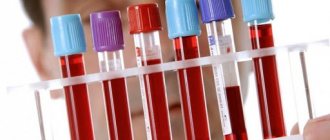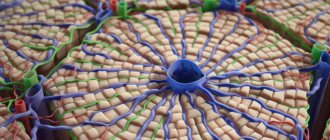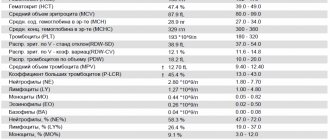Acute leukemia is a cancer of the blood and hematopoietic organ - the red bone marrow, in which normal leukocytes are gradually replaced by immature (blast) cells that are unable to perform their function. As a result, the patient develops inflammation and bleeding of internal organs, which significantly worsens his condition, immunity sharply decreases, and the nervous system is affected. In the absence of qualified medical care, an unfavorable outcome inevitably occurs. The disease is characterized by high aggressiveness: mutated cells quickly spread throughout the body, and their number grows at high speed.
Types of disease
Oncohematologists, depending on the nature of the cell pathology, distinguish two main types of acute blood leukemia.
- Lymphoblastic. Accounts for approximately 15-20% of cases. First, malignant cells affect the bone marrow, then spread to the lymph nodes, thymus gland and spleen, and then throughout the body. A characteristic feature is that mutated cells lack lipids, esterase, and peroxidase. It most often develops in children aged from one to six years and in adults after forty years. In turn, it is divided into two types: B-form with a favorable prognosis for a third of adults and two-thirds of sick children, and T-form with an extremely severe course and a sad outcome.
- Myeloblastic. The disease usually develops in adulthood and affects men and women equally. The treatment prospects are quite optimistic: partial remission can be achieved for 80% of patients, complete recovery occurs in at least 20%.
The full classification of acute leukemia includes many subtypes that differ in morphological, genetic and other characteristics that require specific treatment.
Acute lymphoblastic leukemia
Acute lymphoblastic leukemia (ALL) is a malignant blood tumor that results from a mutation at the level of lymphopoiesis progenitor cells. This type of leukemia is the most common oncohematological disease in children (they account for about 85% of all cases of acute leukemia). In adults, acute lymphoblastic leukemia is observed in 25% of cases of all acute leukemia. An increase in the incidence of acute lymphoblastic leukemia is observed in children aged 2-4 years, then in people aged 50-60 years.
Classification: based on the light-optical characteristics of leukemic cells, three main variants of ALL are distinguished: LI, L2 and L3. In children, the LI variant is more often observed, in adults - the L2 form. When immunophenotyping, four tumor variants are distinguished: - pre-B-cell variant, - early pre-B-cell variant, - T-cell variant (about 15% of all cases), - mature B-cell variant (very rare). After clarifying the variant of ALL, the most appropriate treatment regimen is used and the prognosis for life is assessed. Thus, children with early pre-B-cell variant of ALL have a significantly better prognosis; Mature B-cell acute lymphoblastic leukemias have a less favorable prognosis, especially in adults. Cytogenetic studies reveal chromosomal aberrations in more than half of patients with acute lymphoblastic leukemia. The most serious risk factor is the presence of the Philadelphia chromosome. In children with acute lymphoblastic leukemia, this translocation occurs in 7% of cases, in adults - in 30% of cases. The prognosis is worsened by the presence of high levels of serum lactate dehydrogenase at the time of detection of ALL. One of the leading risk factors is high leukocytosis . It should be noted that in patients over 50 years of age, remission of ALL can be achieved less frequently than in younger patients.
Clinical symptoms in acute lymphoblastic leukemia: at the beginning of the disease there are usually no complaints, or they are very scanty - moderate weakness and fatigue, sometimes pallor of the skin. In the advanced stage of ALL, fever, hemorrhagic phenomena, anemia, etc. may be observed. However, anemization and hemorrhagic diathesis are much less pronounced than in acute non-lymphoblastic leukemia. In acute lymphoblastic leukemia, liver enlargement is not always observed. In young patients with acute lymphoblastic leukemia, moderate diffuse lymphadenopathy is possible. The first manifestations of acute leukemia may also be “unreasonable” low-grade fever, pallor of the skin and mucous membranes, bleeding gums, heavy menstruation, isolated enlargement of the lymph node, persistent pain in the joints, etc. Weakness, fatigue, and sweating are almost always observed. Recurrent ENT infections and herpes are often observed. Bone pain is detected only with a large mass of leukemia cells, i.e. in already advanced cases of acute leukemia. Even with high blastosis in the blood and bone marrow, the patient may maintain sufficient levels of hemoglobin, platelets and neutrophils. and the general condition remains satisfactory.
Diagnosis: since there are no specific symptoms for acute leukemia, the diagnosis is made only after a morphological examination of the blood and bone marrow. The appearance of even single blast cells in the peripheral blood (hemogram) requires an immediate examination of the bone marrow (sternal puncture).
Principles of treatment: hospitalization in a hematology hospital.
Chemotherapy hastily started on an outpatient basis completely excludes the possibility of subsequent cure for the patient, even in a hematology center . It is not recommended to start cytostatic treatment on an outpatient basis; sometimes a single administration of cytostatics or glucocorticosteroids changes the clinical and hematological picture beyond recognition, and subsequently does not allow a correct diagnosis to be made. Treatment of acute leukemia involves: - induction of remission, - consolidation of the resulting remission, - maintenance therapy, - as well as prevention of neuroleukemia. Pathogenetic treatment of acute leukemia is used to achieve complete clinical and hematological remission. Currently, the generally accepted method of intensive combined long-term cytostatic therapy for acute leukemia (total therapy).
Symptoms
The first signs by which one can suspect the onset of the disease are the same for all its forms.
- Noticeable weight loss not associated with food restriction or exercise.
- Fatigue, deterioration in general health.
- Constant weakness, apathy, drowsiness.
- A feeling of heaviness after eating, often concentrated in the left hypochondrium and independent of the amount and calorie content of what was eaten.
- Frequent infectious diseases.
- Increased sweating, especially at night.
- Increased body temperature.
As malignant cells grow in the blood, the symptoms of acute leukemia become more pronounced.
- Pale skin, shortness of breath due to lack of oxygen carried by the blood, anemia.
- Frequent bleeding from the nose and gums, bruising on the skin and mucous membranes, in women - heavy periods.
- Dysfunction of the affected internal organs with its own specific manifestations.
- Severe pain in bones and joints.
- Increased size of the spleen and liver.
- Constant swelling of the hands and face.
Clinical signs are not differentiated in accordance with the classification of acute leukemia, so the form of the disease can only be determined using laboratory tests.
What processes affect the patient’s well-being?
In a person with leukemia, immature lymph and leukocytes, devoid of protective functions, are released into the blood. The level of red blood cells drops and proper oxygen exchange does not occur in the tissues. Peripheral blood supply is disrupted, platelet levels decrease, blood stops clotting, internal organs enlarge and swell.
Oncology develops against the background of hereditary and genetic abnormalities. Leukemia progresses under the influence of alcohol, nicotine, harmful foods, and carcinogens on the body. A special factor influencing the development of blood cancer is radiation exposure of a woman during pregnancy or the effect of large doses of radiation on the body of an adult.
Causes and risk factors
The etiological factors that inevitably become the “trigger” for malignant cell mutation have not yet been precisely established. However, the risks of developing acute leukemia increase significantly if:
- radiation exposure to which a person is exposed;
- infection with certain viruses that suppress the immune system (Epstein-Barr disease, T-lymphotropic virus, etc.);
- unfavorable heredity;
- smoking tobacco;
- prolonged exposure to certain chemical compounds, including medications;
- stress, depression;
- environmental pollution.
Life expectancy with chronic blood oncology
Blood cancer how long do they live? People live with leukemia, which occurs in a chronic form, for a long period of time. Life expectancy can be from 10 to 40 years, but with one essential condition that the disease does not enter the acute stage of its development. To do this, a person must adhere to a certain daily routine and organize his life.
Do not work too much so that the number of hours of rest exceeds the time spent in the labor process by three times. Then leukemia will remain in the preclinical period for as long as possible, and the patient has a chance to live a relatively healthy life.
The transition of blood cancer from a chronic to an acute form is always the first signal that the final stage of blood cancer is very close. In this case, the patient and doctors need to take decisive action to remove the patient from the attack of cancer cells.
Stages
Oncohematologists distinguish the following stages of acute leukemia.
- Initial. It proceeds secretly and lasts from several months to several years. Diagnosed only by bone marrow examination, as blood tests show only minor abnormalities in the white blood cell count and there are no symptoms.
- Expanded. The number of immature cells in the blood increases sharply, which leads to a deterioration in health and the appearance of initial symptoms of the disease.
- Remission. Manifestations of oncopathology decrease, however, a certain number of blast cells remain in the bone marrow (with complete remission - no more than 5%).
- Relapse. The number of immature cells in the patient's bone marrow and blood increases, and his condition worsens.
- Terminal. The most severe stage of the disease, which is characterized by numerous complications of acute leukemia: vital internal organs are affected, extensive bleeding, ulceration and tissue necrosis occur.
Stage 4 cancer with metastases: how long do they live?
In the vast majority of malignant neoplasms, stage 4 is diagnosed when distant metastases are detected, that is, the process is not operable, and the possibilities of drug treatment are not unlimited. The prospects for stage 4 are not bright and worse than for all others.
On the Internet you can find sites with 5-year survival tables for various cancers. Let's look at the life prospects of several patients suffering from metastatic breast cancer. For example, a tumor larger than 5 cm and metastasis to the skin of the breast are not as bad as metastatic lesions of the bones, because in the first case a mastectomy can be done, in the second only chemotherapy is possible. But with secondary bone damage, the prospects are better than with metastasis to the lungs. On the other hand, several poorly differentiated metastatic nodes in the lung are initially unfavorable in terms of long-term prognosis, but they can disappear with chemotherapy, while two or three highly differentiated tumor seedings in the lung tissue do not promise a good response to treatment.
That is, predicting the life expectancy of a cancer patient by stage is equivalent to fortune telling on coffee grounds; it is much more effective to focus on the individual characteristics of the cancer and its response to treatment.
So how long do people live with stage 4 cancer? Different and not at all the same, because in nature nothing is the same at all, although many similar things are found. It is more important to answer the question - how do they live with cancer? Agree, it’s not the best choice to live poorly and for a long time.
Quality of life is the most important category for sick and healthy people; it is the quality of the remaining years of life that should be of interest, and not a specific period that no one knows. In our Clinic they will not tell you how long they have to live, because we are responsible for our words, but through our work we change the lives of our patients for the better.
Book a consultation 24 hours a day
+7+7+78
Diagnostics
A patient with symptoms resembling acute leukemia is prescribed:
- blood tests - general, biochemical, coagulogram;
- removal of bone marrow from the ilium or sternum, followed by cytochemical analysis, immunophenotyping, and morphological analysis of cells;
- puncture of bone marrow and cerebrospinal fluid for cytological and histological examination;
- instrumental studies of internal organs - ultrasound, radiography, CT, MRI to assess the extent of their damage by malignant cells;
- consultations with a neurologist, otolaryngologist, ophthalmologist and other specialists.
Diagnosis of acute leukemia
Acute leukemia does not always manifest itself in the early stages of development, since its symptoms are not considered specific and can indicate a number of other conditions. Therefore, quite often, patients find out about the disease in the later stages, since they do not consult doctors in time.
The main diagnostic criteria are:
— presence of hyperplastic, anemic, hemorrhagic, infectious-toxic syndromes;
- decrease in red blood cells, platelets, presence of blasts in a clinical blood test;
- blastic metaplasia, reduction of erythroid, granulocytic and megakaryocyte lineages in the myelogram and trephine biopsy of the iliac bone.
There are advanced and accurate methods for identifying types of leukemia, but they are expensive and not available in most hospitals in developing countries. Thus, alternative methods have been proposed.
The option is based on the morphological properties of bone marrow images. (https://www.sciencedirect.com/science/article/pii/S0933365712000450) The disease is characterized by the proliferation of immature cells (blasts) in the bone marrow. Their percentage is necessary for the diagnosis of acute leukemia and is set at 30% or more.
In addition, recently introduced classification systems have reduced the blast count to 20% for many types of leukemia and do not require any minimum percentage in the presence of certain morphological and cytogenetic features. https://www.intechopen.com/books/acute-leukemia-the-scientist-s-perspective-and-challenge/classification-of-acute-leukemia
Treatment
Since the list of the most aggressive malignant diseases includes acute leukemia, treatment should begin immediately after diagnosis. The patient is placed in an oncohematology hospital in a ward with special ventilation to remove pathogenic microflora. The main method, as a rule, is chemotherapy, which is supported by transfusion of blood components, detoxification therapy, and prevention of infections. The treatment regimen consists of the main stages:
- induction of remission - exposure to chemotherapy that destroys blast cells in order to achieve the maximum possible remission;
- consolidation - consolidation of achieved results;
- prevention of relapse - preventing the return of the disease.
In certain forms of the disease, bone marrow stem cell transplantation, performed after destruction of blasts using chemotherapy and radiation therapy, has a good effect.
The first stage of treatment takes from 4 to 6 weeks, during which time the patient receives massive therapy. At the consolidation stage, two or three courses of treatment are carried out, after which maintenance measures continue for several years, which are necessary to prevent relapses. Complete remission is achieved when the clone of pathological cells is destroyed and the normal hematopoietic process is restored.
Acute myeloid leukemia status after treatment
The long-term prognosis of each patient largely depends on how well and quickly the disease responds to treatment: the better the body’s first reaction, the more optimistic the prospects.
Remission - no signs of leukemia: the bone marrow contains less than 5% blasts. Blasts are rapidly growing immature, non-functioning white blood cells. , and the number of blood cells is within normal limits. Complete molecular remission means that doctors were unable to detect the altered cells even with very sensitive tests.
Minimal residual disease , MRD: This term is used when, after treatment, abnormal cells are not detected by conventional methods - for example, by standard examination of samples under a microscope, but are detected by modern accurate examinations.
Active disease: after treatment there are more than 5% blasts in the bone marrow, or after therapy a relapse occurred - the disease returned.
Rehabilitation
The list of clinical recommendations for acute leukemia during the rehabilitation period includes:
- measures to improve immunity;
- balanced diet;
- detoxification therapy;
- restoration of intestinal microflora;
- anti-stress psychotherapy;
- improving sleep quality.
During the recovery period, it is important to follow all the orders of the attending oncologist and complete the recommended treatment courses on time and in full.
Causes
As with any cancer, the main cause of malignancy is a violation of apoptosis (programmed cell death), which leads to the proliferation of pathological tumor cells. All this happens against the background of a weakened immune system.
Predisposing factors
- Genetic predisposition - if close relatives suffered from similar diseases.
- Primary or secondary immunodeficiency.
- Exposure to ionizing radiation. People injured during the accident at the Chernobyl nuclear power plant and liquidators of the consequences were exposed to such irradiation. People who have passed
- courses of radiation therapy against the background of other oncological diseases.
- Exposure to chemical carcinogens. This group also includes people who receive chemotherapy for other cancers.








